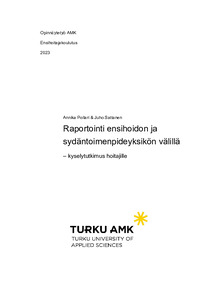Raportointi ensihoidon ja sydäntoimenpideyksikön välillä : kyselytutkimus hoitajille
Sattanen, Juho; Pollari, Annika (2023)
Sattanen, Juho
Pollari, Annika
2023
All rights reserved. This publication is copyrighted. You may download, display and print it for Your own personal use. Commercial use is prohibited.
Julkaisun pysyvä osoite on
https://urn.fi/URN:NBN:fi:amk-2023052313035
https://urn.fi/URN:NBN:fi:amk-2023052313035
Tiivistelmä
Sepelvaltimotautikohtaus on tilanne, jossa sydämen hapensaanti on estynyt tai vaikeutunut tukoksen takia. Ensihoidossa keskeistä on tunnistaa sepelvaltimotautikohtauspotilas ja käynnistää hoitoprosessi, joka mahdollistaa viiveettömän hoidon ja parantaa potilaan ennustetta. Potilaan hoito alkaa ensihoidossa ennalta määrätyllä lääkehoidolla sekä potilaskohtaisesti muulla oireiden vaatimalla hoidolla. Sepelvaltimoiden tukosten poistaminen tapahtuu sairaalassa, jolloin nopea kuljetus hoitoa antavaan yksikköön on tärkeää. Alueellisesti on laadittu hoito-ohjeet, joita tulee noudattaa kyseistä potilasryhmää hoidettaessa. Alueellinen ohje sisältää myös ohjeen raportoinnista ja raportin sisällöstä.
Raportointi ensihoidon ja sairaalan välillä on keskeinen osa potilaan hoidon jatkuvuutta. Raportointiin liittyy useita haasteita, kuten kiireinen ympäristö ja erilaiset epäselvyydet, jotka hankaloittavat tilannetta ja tiedon siirtymistä. Raportoinnin epäonnistuminen voi vaarantaa potilasturvallisuuden.
Opinnäytetyön toimeksiantajana oli yliopistollinen keskussairaala. Tutkimuksen tarkoituksena oli kartoittaa, ilmeneekö ensihoitajien ja sydäntoimenpideyksikön hoitajien välisessä raportoinnissa ongelmia, millaisia ne ovat ja mistä niiden ajatellaan johtuvan.
Tutkimus oli pääosin laadullinen, mutta myös määrällisiä menetelmiä käytettiin. Aineisto kerättiin sähköisellä ja paperisella kyselylomakkeella joulukuu 2022 – helmikuu 2023 välisenä aikana. Kyselyyn vastasi 28 hoitajaa. Puolet vastaajista koki raportoinnin epäonnistuneen. Syynä esitettiin toimintakulttuurista johtuvia asioita, raportissa saatuja puutteellisia tietoja sekä raportin pitkittymistä. ISBAR-menetelmän ja alueellisessa hoito ohjeessa mainittujen tietojen puuttumista ei koettu ongelmaksi raportoinnille. Ratkaisuksi esitettiin selkeän protokollan kehittämistä tilanteeseen, toimintakulttuurin rauhoittamista sekä raportin sisällön muutosta. Myocardial infarction is a condition where the blood and oxygen flow to the heart is disrupted due to a blockage in the coronary arteries. This leads to heart muscle tissue necrosis and reduced contractility of the heart or even death. Recognizing these patients and beginning treatment early in the prehospital setting will improve the patient’s prognosis. The treatment starts in the prehospital setting, but the definitive treatment takes place in an invasive cardiology unit. Effective care pathways that allow rapid and uninterrupted transport straight to the invasive cardiology unit are important.
Communication in clinical handover between prehospital emergency services and the hospital is a crucial part of the continuity of care. What makes this handover challenging is the busy work environment and various ambiguities between professional groups, which may endanger patient safety.
This research was commissioned by a Finnish University Hospital. It aimed to survey if there are problems in communication and reporting between prehospital emergency services and the invasive cardiology unit, the nature of these problems, and where the problems are believed to originate from.
The research was mainly qualitative, but some quantitive methods were used. Research material was collected with a survey form in paper and digital between December 2022 and February 2023. A total of 28 answers were submitted. In half of the cases, communication between the parties was reported unsuccessful. Reasons reported for this were related to work culture, insufficient content of the report, and interruptions that prolonged the report. Not following ISBAR, and not reporting all that the local guidelines direct were not affecting communication negatively. To improve practice in the future, clear guidelines for handover are needed, work culture should be calmed, and the content of a clinical handover report should be revisited.
Raportointi ensihoidon ja sairaalan välillä on keskeinen osa potilaan hoidon jatkuvuutta. Raportointiin liittyy useita haasteita, kuten kiireinen ympäristö ja erilaiset epäselvyydet, jotka hankaloittavat tilannetta ja tiedon siirtymistä. Raportoinnin epäonnistuminen voi vaarantaa potilasturvallisuuden.
Opinnäytetyön toimeksiantajana oli yliopistollinen keskussairaala. Tutkimuksen tarkoituksena oli kartoittaa, ilmeneekö ensihoitajien ja sydäntoimenpideyksikön hoitajien välisessä raportoinnissa ongelmia, millaisia ne ovat ja mistä niiden ajatellaan johtuvan.
Tutkimus oli pääosin laadullinen, mutta myös määrällisiä menetelmiä käytettiin. Aineisto kerättiin sähköisellä ja paperisella kyselylomakkeella joulukuu 2022 – helmikuu 2023 välisenä aikana. Kyselyyn vastasi 28 hoitajaa. Puolet vastaajista koki raportoinnin epäonnistuneen. Syynä esitettiin toimintakulttuurista johtuvia asioita, raportissa saatuja puutteellisia tietoja sekä raportin pitkittymistä. ISBAR-menetelmän ja alueellisessa hoito ohjeessa mainittujen tietojen puuttumista ei koettu ongelmaksi raportoinnille. Ratkaisuksi esitettiin selkeän protokollan kehittämistä tilanteeseen, toimintakulttuurin rauhoittamista sekä raportin sisällön muutosta.
Communication in clinical handover between prehospital emergency services and the hospital is a crucial part of the continuity of care. What makes this handover challenging is the busy work environment and various ambiguities between professional groups, which may endanger patient safety.
This research was commissioned by a Finnish University Hospital. It aimed to survey if there are problems in communication and reporting between prehospital emergency services and the invasive cardiology unit, the nature of these problems, and where the problems are believed to originate from.
The research was mainly qualitative, but some quantitive methods were used. Research material was collected with a survey form in paper and digital between December 2022 and February 2023. A total of 28 answers were submitted. In half of the cases, communication between the parties was reported unsuccessful. Reasons reported for this were related to work culture, insufficient content of the report, and interruptions that prolonged the report. Not following ISBAR, and not reporting all that the local guidelines direct were not affecting communication negatively. To improve practice in the future, clear guidelines for handover are needed, work culture should be calmed, and the content of a clinical handover report should be revisited.
